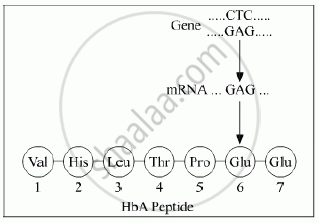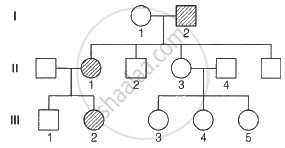Advertisements
Advertisements
प्रश्न
Why is pedigree analysis done in the study of human genetics? State the conclusions that can be drawn from it.
उत्तर
Pedigree analysis is done in the study of human genetics as
(i) It helps the genetic counsellors to guide the couples about the possibility of having children with genetic defects such as haemophilia.
(ii) It indicates that Mendel’s principles are also applicable to human genetics with some modifications found out later such as quantitative inheritance, sex-linked characters and other linkages.
Pedigree analysis is the study of the pedigree for the transmission of particular traits and finding the possibility of the absence or presence of that trait in the homozygous or heterozygous state in a particular individual.
संबंधित प्रश्न
If only one 'X' chromosome is found in a female person, which of the following symptoms she will show?
- epicanthal skin fold
- webbing of neck
- small testis and absence of spermatogenesis
- presence of simian crease on the palm
Given below is the representation of amino acid composition not the relevant translated portion of β-chain of haemoglobin, related to the shape of human red blood cells

(a) Is this representation indicating a normal human or a sufferer from certain related genetic disease? Give reason in support of your answer.
(b) What difference would be noticed in the phenotype of the normal and the sufferer related to this gene?
(c) Who are likely to suffer more from the defect related to the gene represented the males, the females or both males and females equally? And why?
Answer the following question.
Both Haemophilia and Thalessemia are blood-related disorders in humans. Write their causes and the difference between the two. Name the category of genetic disorder they both come under.
Very Short Answer Question.
Give an example of a chromosomal disorder caused due to nondisjunction of autosomes.
Match the Column I and Column II and select the correct option.
| List-I | List-II | ||
| i. | Holandric genes | a. | Pleiotropy |
| ii. | Multiple effects of a single gene | b. | Hypertrichosis |
| iii. | Skin colour in man | c. | Multiple Alleles |
| iv. | ABO Blood types | d. | Polygenic inheritance |
The correct answer is
Mongolism is a genetic disorder which is caused by the presence of an extra chromosome number ______.
Rajesh and Mahesh have defective haemoglobin due to genetic disorders. Rajesh has too few globin molecules while Mahesh has incorrectly functioning globin molecules. Identify the disorder they are suffering from.
| Rajesh | Mahesh | |
| A. | Sickle cell anaemia - an autosome linked recessive trait | Thalassemia - an autosome linked dominant trait |
| B. | Thalassemia - an autosome linked recessive blood disorder | Sickle cell anaemia - an autosome linked recessive trait |
| C. | Sickle cell anemia - an autosome linked recessive trait | Thalassemia - an autosome linked recessive blood disorder |
| D. | Thalassemia - an autosome linked recessive blood disorder | Sickle cell anaemia - an autosome linked dominant trait |
Fused ear lobes appear in the progeny due to an autosomal recessive gene. Work out the genotypes of number in the given pedigree.

Short stature in females, webbed neck absence of menstrual cycle and sterility are characteristics which of the following disease?
Why is thalassemia cotegorised as a Mendelian disorder? Write the symptoms and explain the causes of the disease. How does it differ from Sickle cell anaemia?
